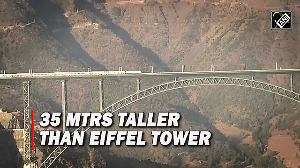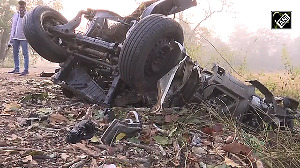With crude prices exceeding $70 a barrel, the subsidy burden for oil marketing companies has become unmanageable. Subsequent to the US invasion of Iraq in 2003, prices have sky-rocketed. Tensions in West Asia remain, implying oil prices will continue to remain at $60 plus levels.
Since the failure to raise prices locally has crippled OMCs, the government is expected to allow a combination of increased prices in petrol and diesel and issue fresh oil bonds that do not get reflected in the fiscal deficit. While that will take some of the pressure off the OMCs, the current system has too many flaws.
No transparency: While oil producers like ONGC are forced to sell at a discount to share the burden of under-recoveries (between $14-16 a barrel in 2005-06), OMCs are supposed to be paid based on import parity pricing, which means they get protection arising out of a difference in customs duty rates (petrol 10 per cent, and crude 5 per cent).
Assuming a 15 per cent value addition, this implies an effective protection to the OMCs of 38 per cent (see www.planningcommission.nic.in/reports/wrkpapers/wp vat.pdf) on petrol/diesel production - if you assume a 20 per cent value addition in the refining process, this still remains a high 30 per cent.
Being assured of protection, the incentive for OMC to reduce cost falls. Conversely by not paying OMC market prices, the government has adversely affected their ability to invest in modern refineries.
So HPCL Mumbai earned a margin of $3.22 in 2005-06, while the corresponding margin for Reliance was about $10-12 a barrel. Even if we were to attribute Reliance's higher margin to its processing of high sulphur crude and getting more value-add products, this is indicative of considerable fat in the system.
There is also the question of cess collected under the OIDB Act. Since 1974, about Rs 60,000 crore (Rs 600 billion) was collected under the OIDB Act, of which Rs 59,098 crore (Rs 590.98 billion) was eaten up by the finance ministry.
The cess was not used to reduce the price for the consumer. So when OMCs say they're facing potential under-recoveries of Rs 73,500 crore (Rs 735 billion) in 2006-07, it is difficult to assess the actual number.
Government gouging: About 55 per cent of the retail price of Rs 49.16 per litre of petrol in Mumbai goes to the Central and state governments by way of taxes. An increase in petrol prices is as much on account of the government's insatiable appetite for revenue as it is on the surge in crude prices.
The Central government forgoes revenues {Rs 158,661 crore (Rs 1586.61 billion) in 2004-05) by way of various tax concessions and then excessively taxes the petroleum sector to make this up.
While kerosene prices are kept low in the name of the poor, the excessive difference leads to adulteration with diesel. India's kerosene prices are lower than in Pakistan or Bangladesh. While diesel costs Rs 30.45 per litre in Delhi, kerosene costs barely 30 per cent of this.
In Bangladesh, kerosene costs a fifth more than diesel, and in Pakistan it costs 90 per cent of what diesel does. The failure to raise prices has also ensured consumers feel no compulsion to reduce consumption.
What the government needs to do is to appoint a Petroleum and Natural Gas Regulator who lays down a framework for pricing of petroleum products and reviews prices periodically.
OMCs should have the freedom to price their products subject to a regulated ceiling. Pricing of petrol and diesel should be linked to international prices of crude with no cross subsidisation.
The subsidy on kerosene and LPG should be funded from the Central Budget similar to the way in which state governments pay State Electricity Boards for free power to farmers.
Another important issue is to consider the use of alternative fuels while pricing products.
Alternative pricing: The accompanying table tries to develop one such framework, and calculates the costs of producing one kilolitre of petrol based on only crude oil vis-a-vis a situation in which 10 per cent of ethanol is blended.
Some of the assumptions made are:
- Pricing of petrol and diesel be based on a pre-agreed sourcing of crude, say, 70 per cent imported, 20 per cent ONGC, and 10 per cent of alternate fuels such as ethanol.
- The 70 per cent imported portion would be priced based on import parity pricing, albeit at a lower customs duty rate of 7.5 per cent on petrol as against 10 per cent currently.
- ONGC's 20 per cent is to be sold at international prices. In this case, refining margin on processing of crude is added.
- For the 10 per cent part, ethanol is costed at purchase price from sugar companies plus freight - having assumed that no excise duty/VAT is payable on ethanol.
- Equated freight/refining and marketing margins taken at current levels.
- Excise duty is assumed to be at a specific rate and not ad valorem - that on petrol is Rs 14,500 per kilolitre and diesel Rs 5,000 per kilolitre. This corresponds to a per litre sale price in Delhi of petrol at Rs 43.49 and Rs 30.45 for diesel.
- Customs duty is fixed at Rs 815 per kilolitre and this corresponds to a 5 per cent duty on a crude price of $55. Until about 1996, excise and customs duty were at specific rates.
- Sales tax value for states to be kept at current MRP levels.
The new system will make pricing of petroleum products transparent. An OMC that reduces cost through better buying, use of technology or alternate fuels could decide to increase market share by cutting prices just like telecom companies have done.
Making customs duty/excise specific will prevent unjust enrichment of the government arising from depreciation of the rupee (rupee depreciated by 3 per cent versus the dollar in the past one month) or increase in crude prices.
At the same time, it will protect revenues if crude prices fall drastically. It would re-establish the financial viability of OMCs and provide funds for expansion/modernisation. It will also encourage the use of alternate fuels.
Are both the Left and the Congress driving OMCs bankrupt because they want to sell these navratnas to oil majors - mulitnationals or Indian? I hope not.
Sanjeev Nayyar is the CEO of Surya Consulting. Some of the suggestions are borrowed from the Rangarajan Report 2006.






 © 2025 Rediff.com -
© 2025 Rediff.com -